Culture is created one meaningful conversation at a time. From 1-on-1s with a Supervisor to company-wide communication, every conversation counts in building an authentic, purpose-powered culture. Through our Ovrflo Culture System, we implement intentional, scalable, purpose-led conversations at every level of your company.
Our 8-part culture system closes the communication gap, increases engagement, and builds loyalty.
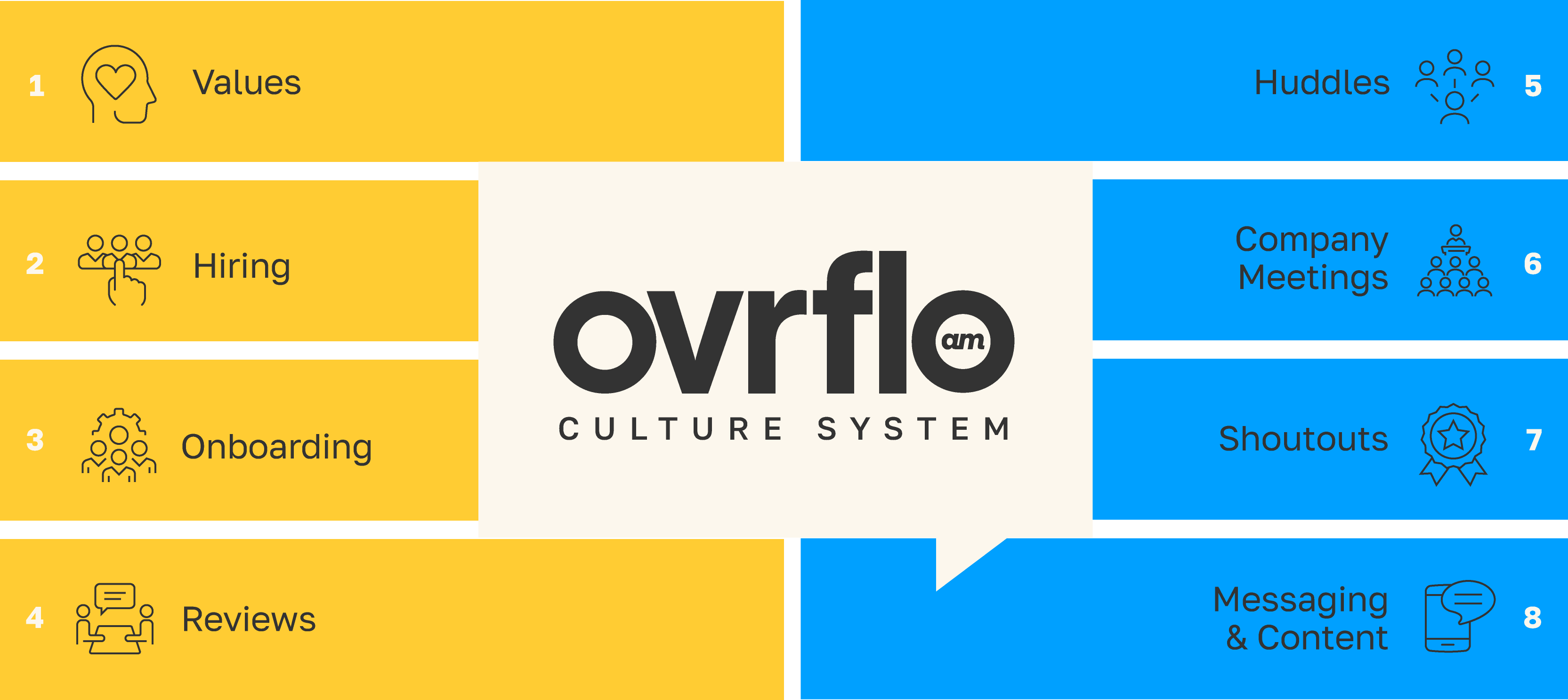
Our 8-part culture system closes the communication gap, increases engagement, and builds loyalty.
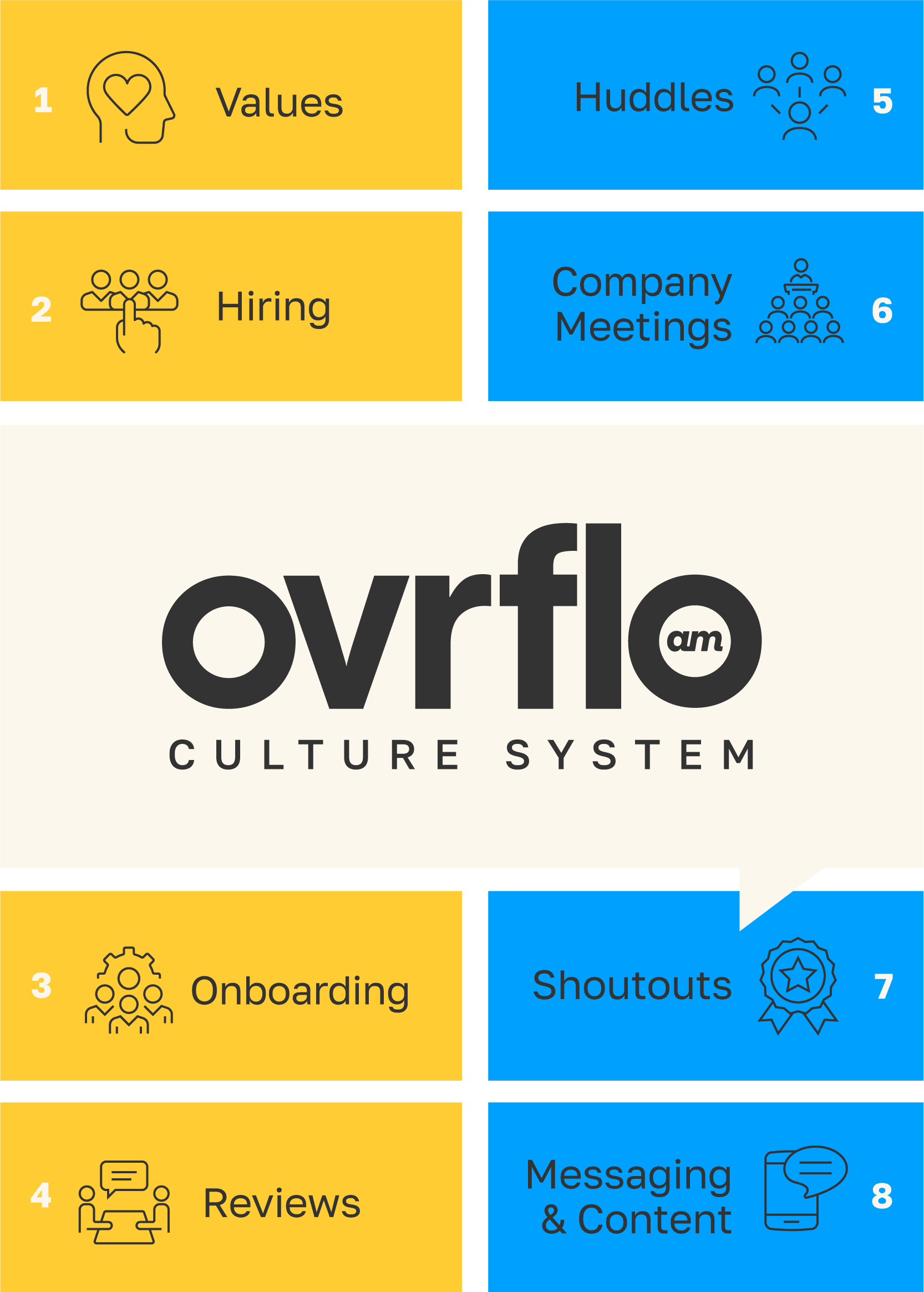
1. Values
As with most culture initiatives, we start by identifying and/or solidifying your purpose, vision, values, and mission. Most companies have already identified their values, but very few companies have made them functional or relevant to their daily operations. Ovrflo changes that.
We must change it if we’re going to help you build a scalable, purpose-led culture. We must have a set of essential principles and behaviors that define what culture means in your company. We must clarify what behaviors are essential for your team to fulfill your unique purpose together and achieve your vision.
To identify your values (or confirm the ones you have are authentic), we start with a collaborative session with your leaders and/or managers to uncover the type of people and behaviors that make your company unique. We talk about the superstars in your organization. We talk about their actions, reactions, thoughts, and characteristics to uncover the type of people needed to fulfill your purpose and vision. We then use our communication skills to polish, simplify, and sizzle up your values to be as inspiring as possible.
We recommend limiting your values to 5-7 words. They can be phrases if you want, but most of our clients choose singular words. Sometimes, we’ll get creative and make acronyms out of them or find other ways to make them easy to remember, which is the main point. Once those 5-7 value words are finalized, we then create what we call Action Statements for each value.
Action Statements
One of the most common gaps in making values real in your culture is the lack of clearly defined descriptions of each value. Action Statements are written phrases that explain what it means to live out each value in your organization. These statements help limit the possibility of misinterpretation and make them easy to learn and remember. We recommend limiting it to 3 statements for each value.
Here is an example from one of our clients for their value of Innovation:
- I challenge myself to think outside of my comfort zone.
- I see obstacles as an opportunity for creative solutions.
- I use available resources to turn ideas into reality.
When your values are crystal clear, you can recognize and reward people based on this simple, shared language. And yes, the opposite is also true. Clear values also make the wrong people stick out like a sore thumb, which, like it or not, may be keeping you from realizing your potential as well.
Our goal with this step is to create and crystallize values that are a valuable part of your purpose messaging, the foundation for the remaining parts of our Ovrflo Culture System.
2. Hiring
Your hiring process is the entry point for having meaningful conversations with your employees. It’s your opportunity to establish relationships on the foundation of your purpose, vision, and values. This is usually one of the fastest returns on your purpose-led brand investment.
Recruiting
Your Website and job listings should lead with your story, purpose, and values. It should also demonstrate how you live them out in and through your company. We’ve seen over and over again how applicants read your purpose messaging online and mention it early in their interview process. It draws them in and they want to be a part of a company that cares about impacting people.
Phone Screen
When your culture is built on your purpose and values, it changes how you vet candidates. The first stage is a simple phone screen that should last 20 minutes or less and is done by an administrate staff member to save time for subject matter experts and managers. We’ll write up a phone script that focuses on values and culture fit for this first call. You’ll see if they care about what you care about, and if they will thrive in your values.
In-person Interviews
Once they get past your phone screen, then vet their job skills fit at the in-person interview. This is when you bring in your Hiring Manager and/or Subject matter experts. They’ll ask similar questions to the phone screen AND add in technical job knowledge questions to vet their abilities. They should never be talking to someone who is not a likely culture-fit based on the phone screen.
3. Onboarding
Onboarding is the process that ensures new hires are ready for whatever comes at them – from policies and procedures to integrating into your culture.
Most companies struggle to create an effective onboarding process, yet the data shows that a great onboarding experience drastically improves retention and productivity. It’s time to turn this weakness into a strength for your company.
Create a Checklist
We suggest creating Onboarding checklists for every role in your organization. A good checklist will map out everything that needs to get done and go well in the first 90 days. A lot of the items apply to all roles so start with those. For example, can we finally put to rest having employees sit around for days waiting for their laptops to be ready? Let’s make it a goal that they have their computers, calendars, software, and logins all in place and ready to work before they show up on day 1. That alone would help a lot of first weeks go smoothly.
Map out the items related to each specific role such as production-related techniques, processes, and tools. We like to line out what each role needs to know, who is going to train them on each item, and when it’s going to happen (Pre-day 1, day 1, 15 days, 30 days, etc)
82%
Organizations with a strong onboarding process improve new hire retention by 82% and productivity by over 70%.
- THE BRANDON HALL GROUP
12%
Only 12% of employees strongly agree their organization does a great job of onboarding.
- GALLUP
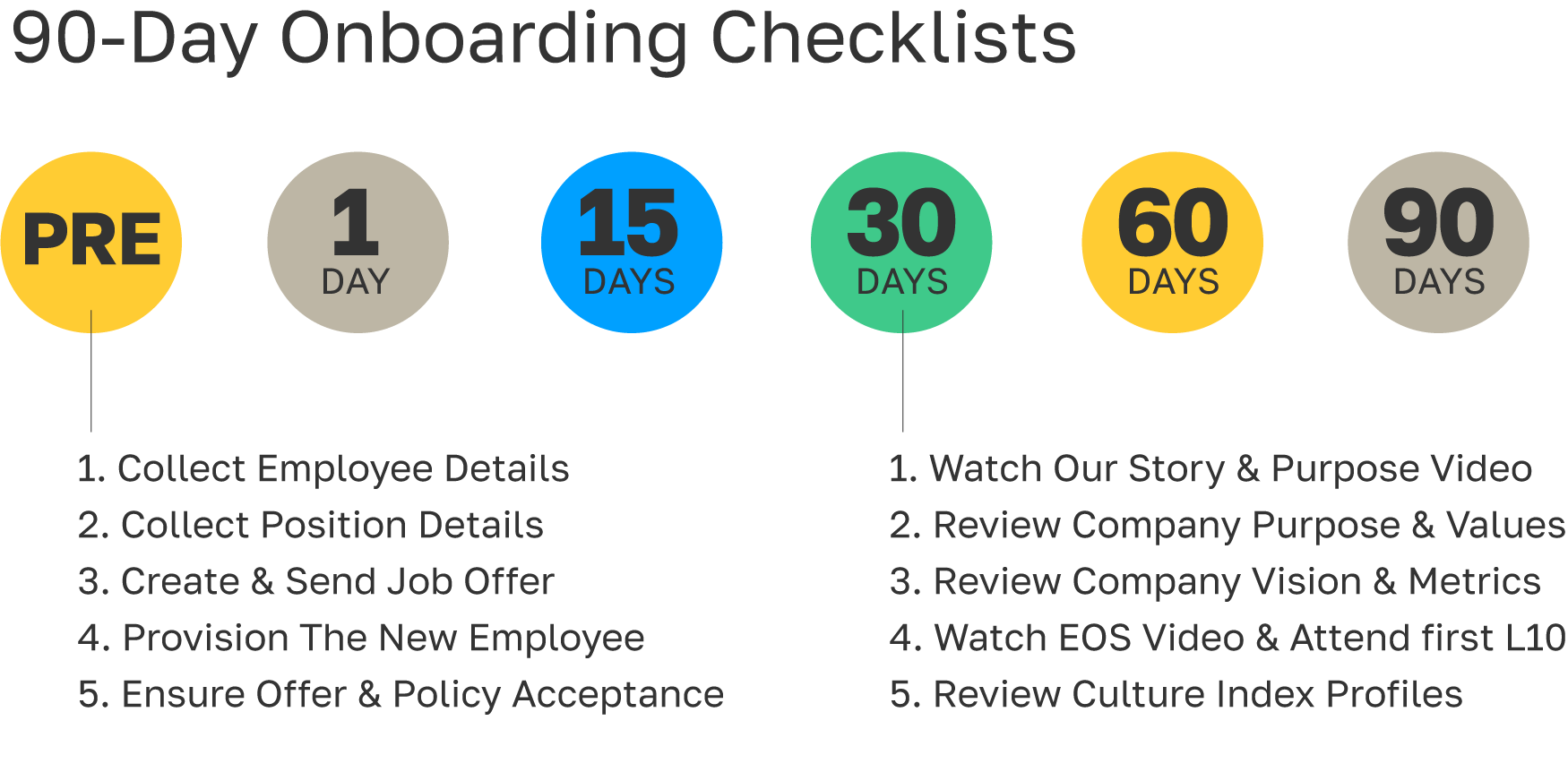

Putting your Check lists into a program like Asana® make Onboarding easy to schedule, delegate to other staff, and create reusable templates for every role. You could also use a basic spreadsheet to accomplish something similar as well.
Create Training Content
One major goal of your improved Onboarding process is to speed up learning at scale. Creating checklists and content takes a lot of work upfront but pays off every time you hire a new employee. The improved experience is not only for new employees. Think of the time you and your leaders will save by not having to lead as much individual training every time.
To simplify the training content creation process, we list out and prioritize which content should be included. Start with the processes that every employee needs to go through. We’ve found that creating simple presentation decks and recording the presenter using Zoom® or similar software make these videos easy to produce at a quality level that works for most companies.
These 10 to 15-minute-long videos usually cover your company story, purpose, values, vision, services, products, and more.

Examples of Training Content Presentation Deck Slides
4. Reviews
If your culture is going to be more about people and purpose than paperwork, we have to have two-way communication and feedback with our team. We must be intentional to stay in the know about how it’s going and how each employee is fitting in. These check-ins help build meaningful relationships at work and create development paths that keep your team engaged.
Quarterly Reviews
A Quarterly Review is an honest conversation between an employee and their Supervisor that takes place every 90 days. In each 20-minute review session, you should cover:
- What’s working and what’s not working (energy and tension points, and how to solve them)
- Review their growth in living out the company values
- Review how they’re living out their purpose and the company purpose
- Identify disengaged employees (smoke-out issues related to them or their coworkers)
Some organizations like to add more performance-related items to their quarterly reviews. Still, we tend to guide that the quarterlies be more of a conversation than a performance review. If you have good weekly scorecards and meetings, then performance tends to get measured and managed in that environment, leaving time for the quarterlies to be more high-level and relational.
Annual Reviews
An Annual Review is similar to the Quarterly review format. These cover the same things as in the Quarterly Review but add more time to review the entire year’s progress and set a clear path for the next 12 months:
- Compliment the previous 3 Quarterly Reviews
- Review of overall strengths and weaknesses
- Review compensation and career path development
Be Present
These conversations are an opportunity to be present with your team. Set the grind of work aside and let them know you care about them and are serious about your culture. It’s an investment that will pay off for you and your organization.
The last four parts of our Ovrflo Culture System are focused on Internal Communication.
Internal communications is the part of the company responsible for effective communication to all employees. It helps everyone stay on the same page and focused on the things that help you achieve your goals together.
Great communication doesn’t just happen. It takes an easy-to-follow structure and people willing to follow it for it to become great and stay great throughout your entire company. Most organizations struggle, so you’re not alone if that’s experience. However, it may be costing you more than you realize.
There is often a Communication Gap in your culture. This gap represents all the things you think you are communicating. If you haven’t said it many times, in many ways, then you are fooling yourself.
The ugly outcome of this gap is that it leads to division, which leads to a toxic culture and disengaged employees. It destroys culture so fast. And by the time you figure out where the misinterpretation started, it’s nearly impossible to correct the poor thinking and false conclusions.
Humans need to hear things at least 8 times for the idea to connect. For those of us who are constantly distracted by our devices, double it. The more we communicate, the less room for miscommunication, misunderstanding, silos, and toxicity. The following tools and tactics are how we help eliminate this gap in your culture.
Are you ready and willing to put in the work involved to solve this problem for good?
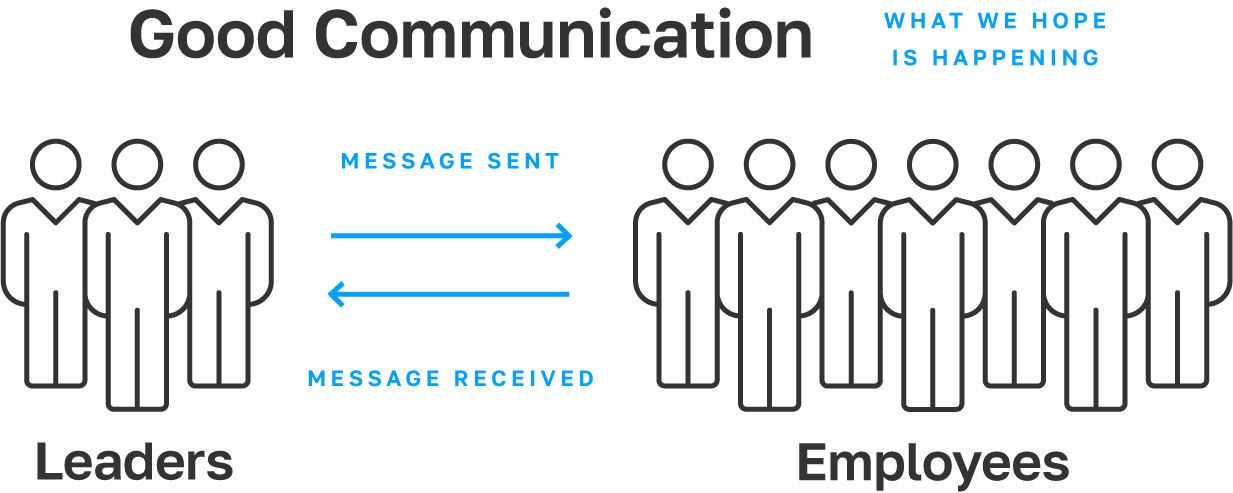
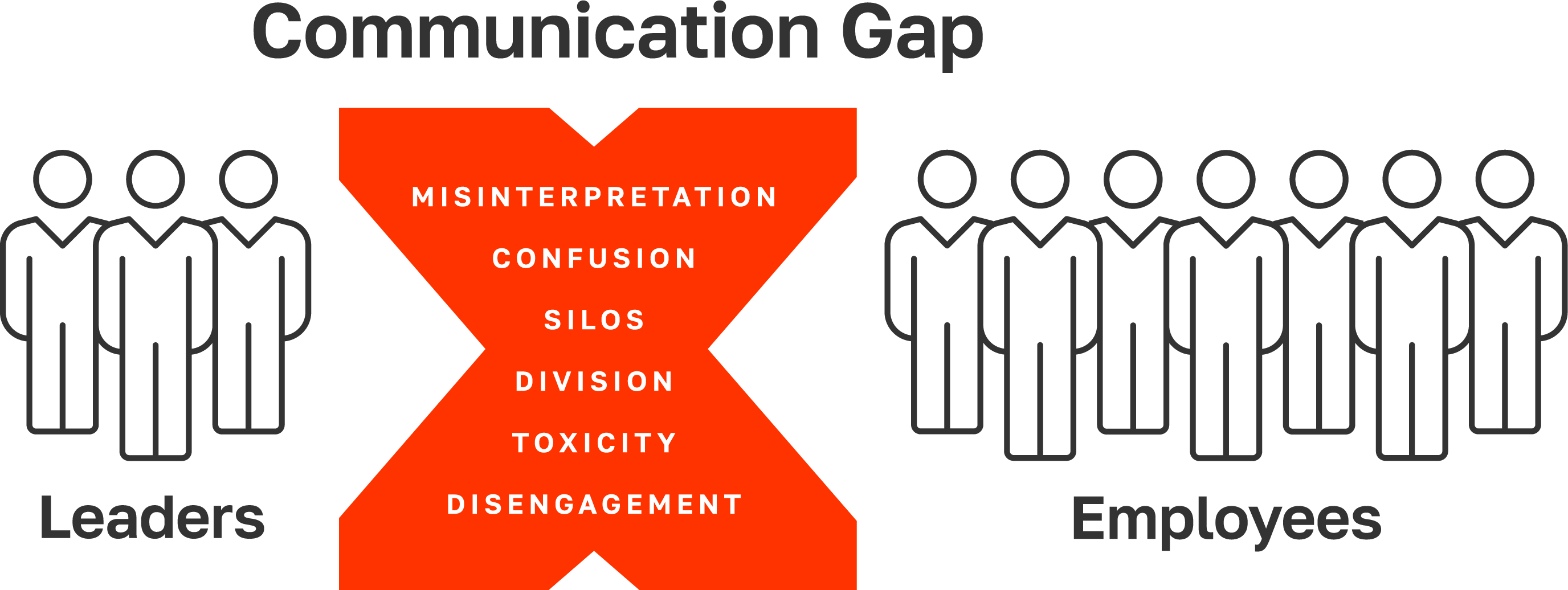
What should we communicate about?
Purpose, vision, values, and mission are the core of internal communication content, as they drive engagement and buy-in. You should also share other important practical information that effectively and efficiently keeps your team informed. See the diagram for more ideas of what to include.
Which type of information should you be communicating more regularly?
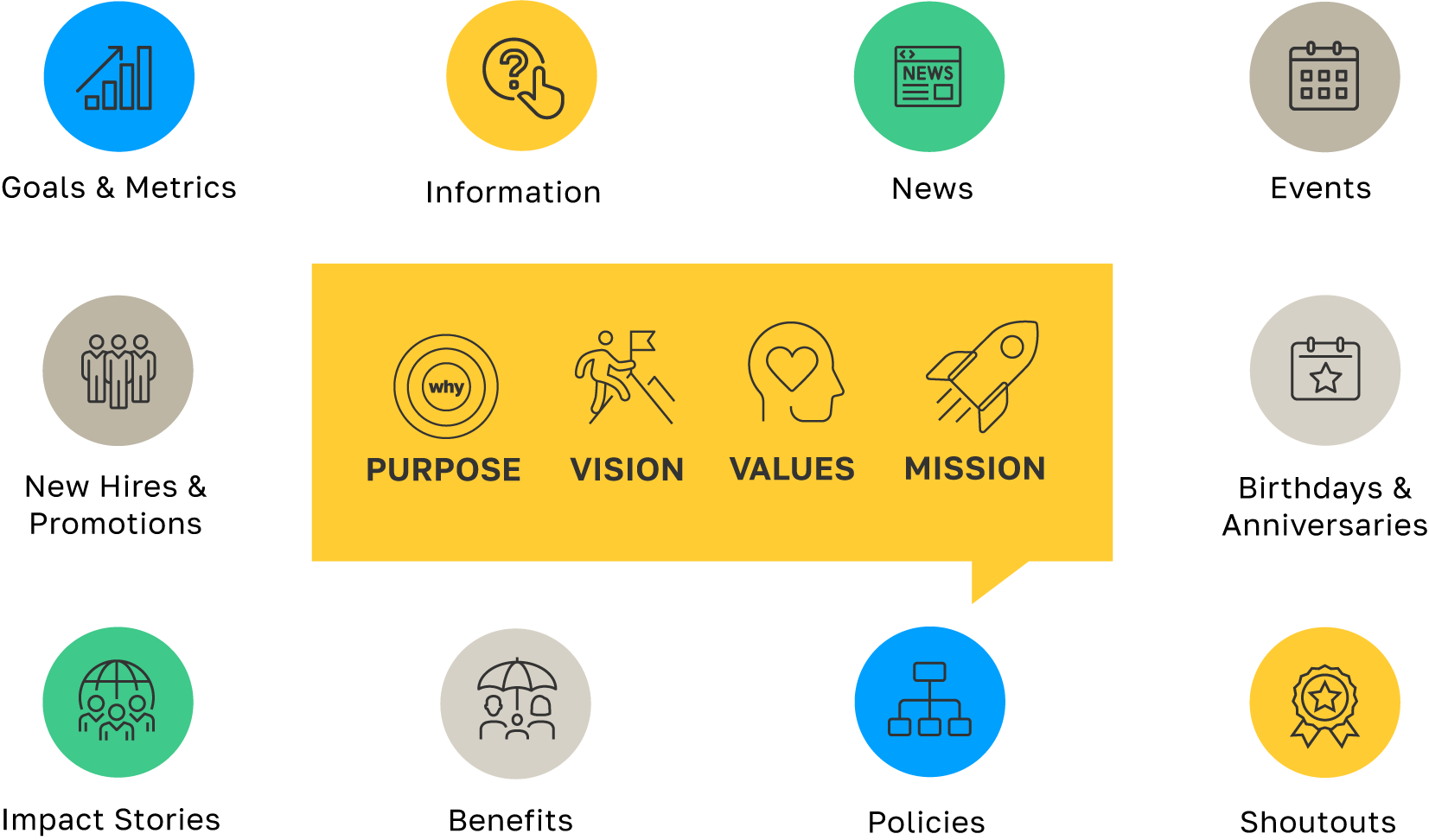
How do we communicate it?
Primary communication channels are direct conversations with another person, where you or a leader speak directly to your team. Direct conversations have the highest chance of comprehension so we want these types of intentional communication in your company. This can happen in weekly Huddles which are 15-minute or less department-level meetings. We also recommend having Company Meetings every 90 days. We’ll review both in more detail below.
Secondary communication channels are indirect. This type of information is typically distributed via a device or technology that is delivered regularly to your staff. Though not as effective as direct communication, secondary channels surround your culture daily and display the right content in front of your team, to remind them of what matters most. We’ll review several secondary communication channels we use below so keep reading.
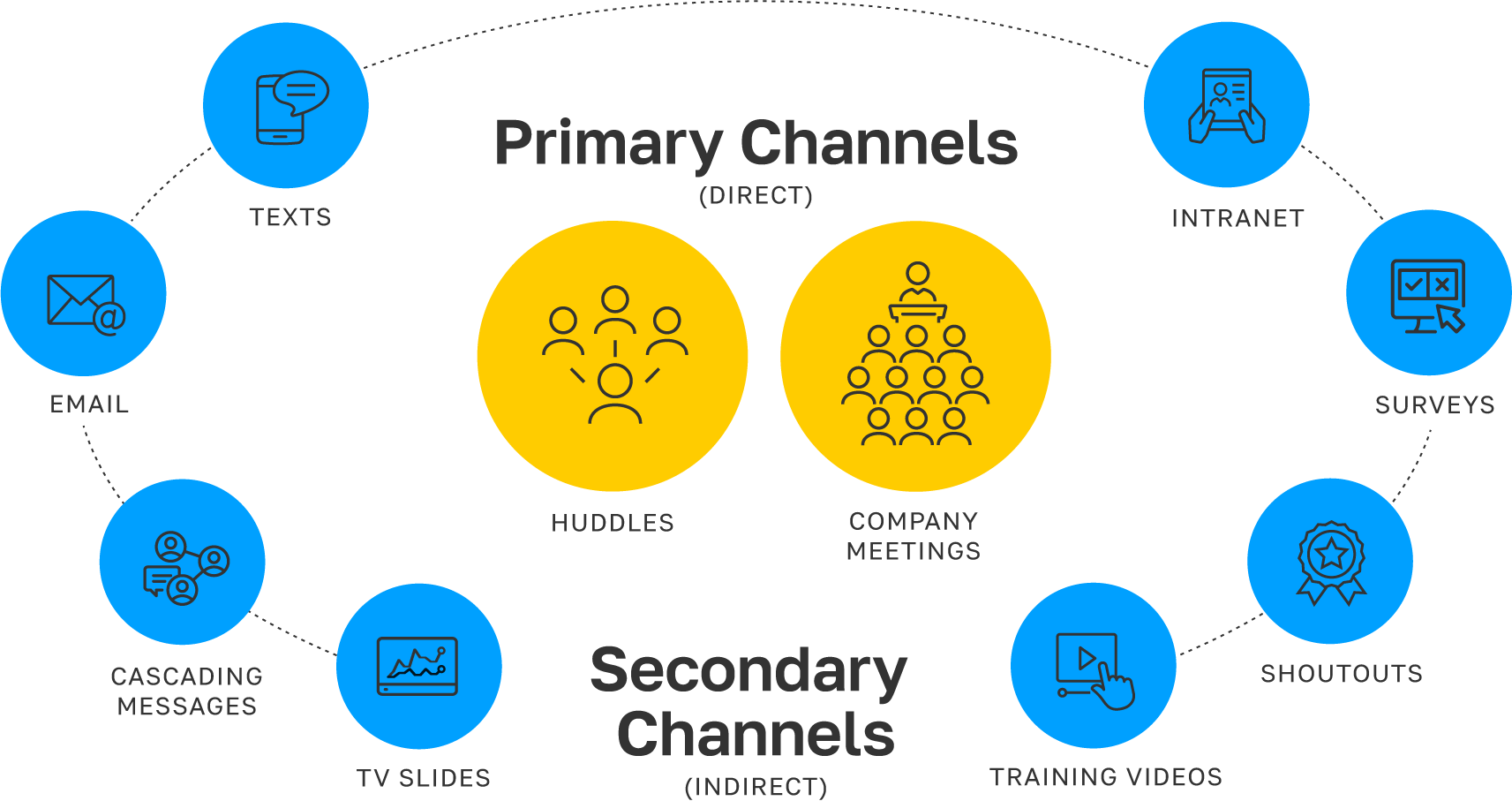
5. Huddles
Huddles are meetings where your department team gets together for 15 minutes weekly to share important news and information. The meeting happens on the same day and time each week, and the Huddle Leader goes over the company-wide items and any department updates for that department/team.
Designated Huddle Leaders lead each Huddle group. We recommend having one Huddle Leader and one alternate Huddle Leader per Huddle group. That way you have a backup to cover the main leader if they are out, and it’s a chance for others to develop their communication skills. Huddle Leaders do not necessarily have to be the departmental leader. They need to be good communicators who can follow the plan, and have passion behind what they are sharing. Huddle Leaders follow a Huddle sheet distributed weekly via email to ensure the Huddles are communicating what the company has prioritized each week.
We provide Huddle Sheet templates to help get the process started. The content tends to improve over time as the organization learns what information to share and gets better at delivering the info effectively.
We often get logistical questions on how to set up the huddles with different types of staffing situations (ex: multiple locations, distributed staff, day shift vs. night shift, different languages, etc). There’s no set rule that it has to be done a specific way other than to find a rhythm and stick with it (ex: weekly or bi-weekly, zoom or in-person, etc).
6. Company Meetings
Company meetings are where the whole company gets together, once every 90 days, to hear directly from your Leadership Team about how the company is doing, along with the latest news and updates. Together, you review your values, and goals, and recognize the team’s achievements and milestones.
Company meetings are a direct communication channel that delivers high ROI in the battle for your culture. The whole staff gets to hear from you as you reset and remind everyone why your company purpose is worth achieving, and how you really can make a difference in the lives of your customers, employees, and beyond.
There may be a few logistical challenges to overcome for those who have distributed teams or multiple languages to factor in. All of those obstacles can be overcome. That may mean that you do smaller groups or multiple meetings. You may need to record one of the meetings and then have smaller groups sit down and watch the video version with a facilitator on hand to ensure everyone is focused and has a chance for questions and feedback.
7. Shoutouts
Imagine your employees sharing authentic stories about other employees who truly care about your customers, your company and each other. Imagine your employees knowing and living your values so well that they recognize and honor each other for doing so — without you having to stay on them all the time to do so. Imagine a tool that allows your team to do this from their computers or smartphones and have it notify everyone regularly that it is happening.
What you are imagining is a reality for our clients; we call this a Shoutout.
Shoutouts are positive, life-giving recognitions that increase buy-in from your team and value to your values. Shoutout stories are also used as content across your other internal communication channels and meetings to reinforce their value.
Making Shoutouts easy to submit from any device is key to getting people to engage in the process. We offer our Ovrflo App to help your team submit shoutouts, view your purpose and values messaging, view a team member directory, and several other important resources. It’s an online, browser-based application that’s easy to access from anywhere.
To submit a shoutout, you simply log in to the Ovrflo app, select the employee, select which value they lived out, select the action statement they specifically displayed, and then share the brief story of what happened. From there, our default distribution settings are to send an individual text to the person receiving the shoutout, and an email to the whole staff. The Shoutout also displays in the Ovrflo App online. There are settings to set the right frequency that fits your organization best, but no matter how you choose to share these, they will bring appreciation to your team and elevate your values like nothing else.
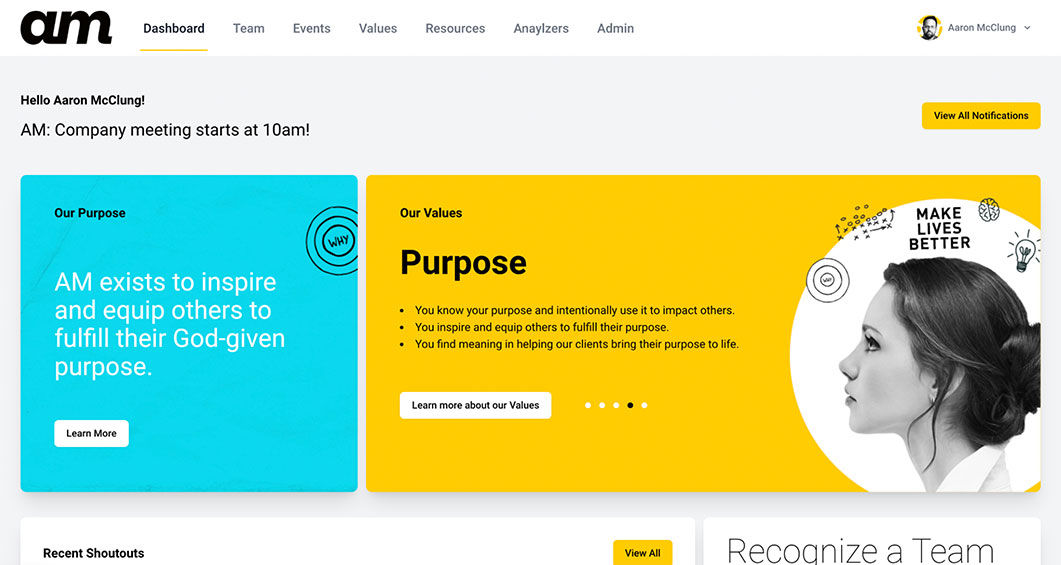
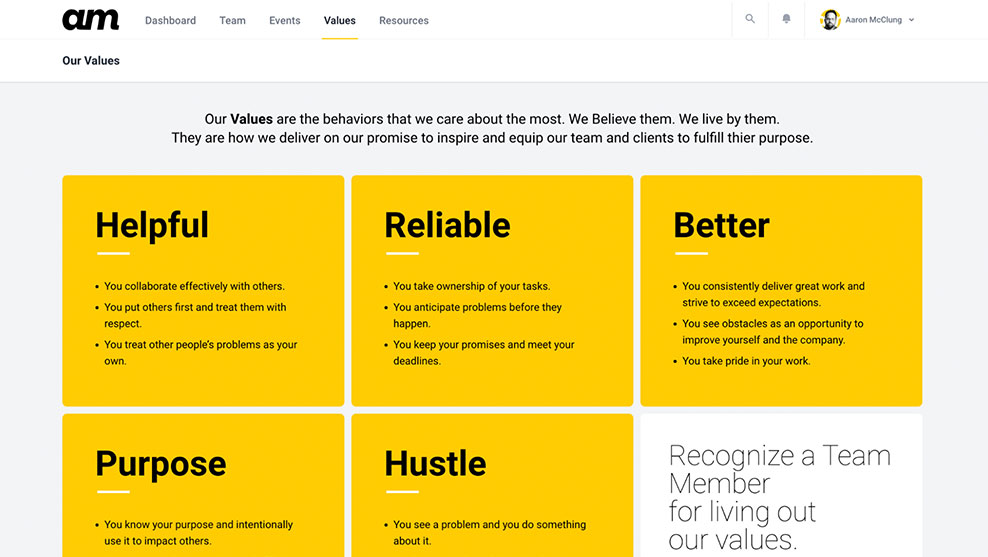
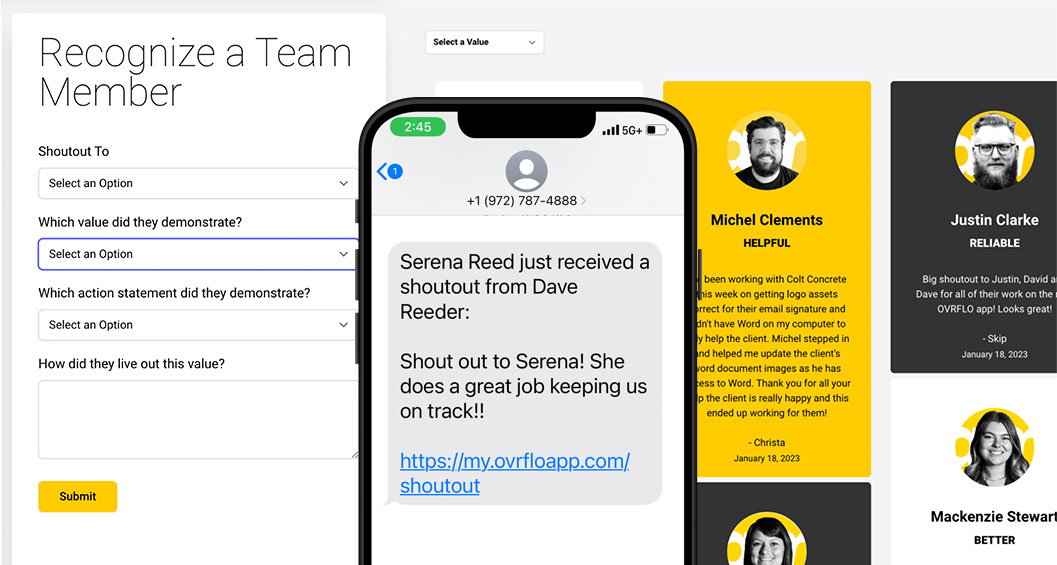
8. Messaging & Content
The last part of the system is to make sure the ongoing messaging and content are created, managed, and distributed with consistency and quality.
You may think it would take a ton of time and resources to get all of this done each week. However, we’ve done everything we can to streamline the implementation and maintenance of this system. Once the system and tools are in place, your internal communication process should be completed within a few hours of work time each week. Here’s how it works.
Set up a Communication Team
We suggest creating a Communication Team of one or two staff members who are responsible for writing and distributing the information each week. That may take 4-6 hours to pull together, edit and load into the various channels (TV slides, Text messages, Huddle Sheets, etc). We suggest that they meet for one hour with a senior leader each week to review the content, prioritize what goes out when, and plan for future items.
We do not believe this level of communication requires a full-time position. This should be easily done in just a few hours by existing communication, administrative or HR-related staff members.
Set up the Tools
Text Messages
Texting is the preferred method of communication for most employees. It’s also the most effective with 98% of text messages being read within 3 minutes or less.
The Ovrflo App includes the ability to schedule and send text messages to your team. Each client prefers a different amount of text messages to be sent, but we typically see that at least three text messages go out to their staff per week. These can include urgent weather-related texts or general communication related to announcements, shoutouts or other purpose-related content.
The Ovrflo content, along with these text messages can be shared in English or Spanish. This allows each employee to choose their preferred language for these messages.
We have not had any major issues with employees complaining about texts to their personal mobile phones. They tend to appreciate the communication and see it as essential to their jobs.
TV Slides
We recommend that TVs be installed in your facilities to be used as billboards for weekly communication. Our team provides templates and software recommendations that make these TV slide shows affordable, easy to implement, and maintain in any location. The software allows for remote online management of the TV content.
Set up a Workflow
The more organized your team is the more efficiency you can gain in implementing great internal communication. A workflow will be established to know what days information must come in by, be processed on, and then distributed each week. The Communication Team meeting should happen on the same day and time weekly to keep this work efficient. Other departments learn when that cutoff time is and that they need to cascade any items for communication within that cycle.
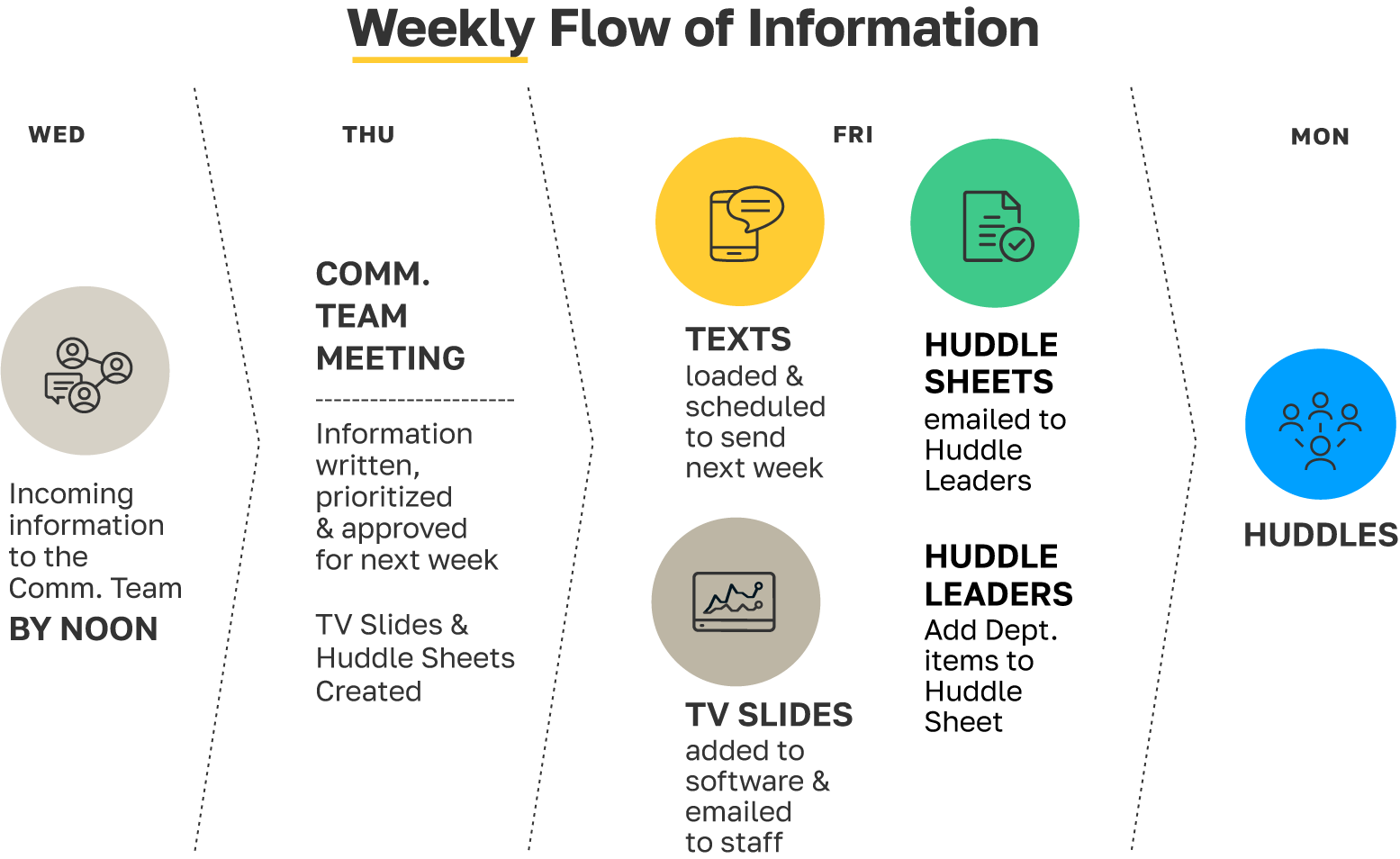
Implementation
As you can see, the Ovrflo Culture System creates meaningful conversations throughout your organization. Most companies should not try to do all of this at once. It needs to be built upon in layers to successfully adopt and ensure long-term success. To begin, we typically pick one part of the HR side of the processes and one part of the Internal Communication side (Ex: Onboarding and Messaging/Content). Implementing all 8 parts of the system takes most organizations between 12 to 18 months.

- Are there areas of your culture that could use more intentional and meaningful tools and processes?
- Are your purpose and values the foundation for your HR and internal communication processes?
- Which areas would be the best place to begin?
The best time to start is now.
Let’s find a time to discuss how we can help your culture be more transformational in your organization.

